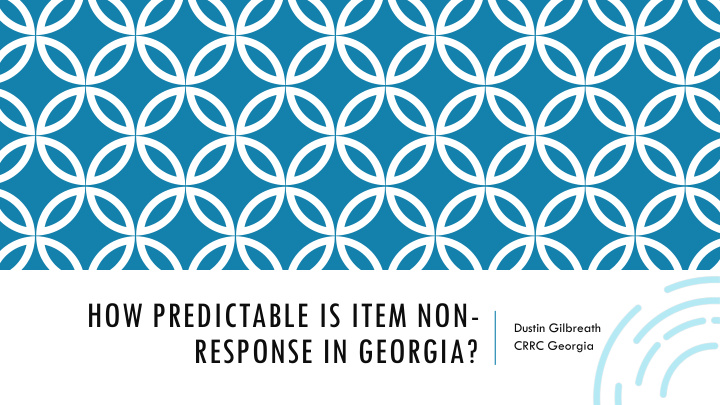



HOW PREDICTABLE IS ITEM NON- Dustin Gilbreath RESPONSE IN GEORGIA? CRRC Georgia
TODAY Background Research questions Methodology 1 Results 1 Methodology 2 Results 2 Conclusions Questions and answers
ITEM NON-RESPONSE Refuse to answer and don’t know questions regularly considered item non -response Multiple imputation commonly used to deal with this after a survey, but based on a number of assumptions Sometimes these are problematic and can bias results more than the use of list-wise deletion At the end of the day its better to have a response than use multiple imputation
RESEARCH QUESTIONS What predicts non-response in Georgia? Are predictors of non-response similar across surveys in Georgia?
METHODOLOGY FOR ANALYSIS 1 Data Caucasus Barometer 2017 N = 2379 CAPI EVS 2018 N = 2194 CAPI Poisson regression Dependent variable 1 = number of DKs a respondent reported during the survey on questions asked to every respondent Dependent variable 2 = number of RAs/NA a respondent reported during the survey on questions asked to every respondent
RESULTS
Predicted don't know count by various demographic variables (EVS Georgia 2018) Minority Ethnicity 15,49 Likely Georgian 5,66 Education level Settlement type Capital 9,32 Urban 9,69 Rural 9,09 Higher 6,10 Middle 9,46 Lower 14,22 56+ 12,46 Age group 36-55 9,38 18-35 7,03 Female 10,32 Sex Male 7,91 0,00 2,00 4,00 6,00 8,00 10,00 12,00 14,00 16,00 18,00
Predicted no answer count by different social and demographic groups (EVS Georgia 2018) 2,20 Minority Ethnicity EVS 1 0,39 Likely Georgian Education level Settlement type 0,57 Capital 1,21 Urban 1,16 Rural 0,75 Higher 0,76 Middle 1,41 Lower 1,16 56+ Age group 0,86 36-55 0,80 18-35 0,86 Female Sex 1,06 Male 0,00 0,50 1,00 1,50 2,00 2,50
CORRELATION BETWEEN DK AND RA CB = 0.009 EVS = 0.15
METHODOLOGY FOR ANALYSIS 2 Pooled data with OLS on: Dependent variables RA count/ Questions in included in the analysis DK count/ Questions in included in the analysis Independent variables Survey Age Ethnicity Education level Settlement type Sex Second model with Their interactions with which survey it was Too much censured data to run a tobit, particularly with the DK variable
MODEL 1 Don't know Refuse to Answer Estimate Std. Error T p Significance Std. Significa Estimate Error T p nce (Intercept) 2.0419 0.2552 8 1.56E-15 *** (Intercept) 0.21536 0.07586 2.839 0.00455 ** Urban 1.1182 0.1877 5.958 2.75E-09 *** Urban 0.1808 0.05579 3.241 0.0012 ** - Rural 1.1926 0.1822 6.547 6.51E-11 *** Rural 0.13878 0.05414 -2.563 0.0104 * - Female 1.0233 0.1519 6.736 1.83E-11 *** Female 0.04005 0.04516 -0.887 0.37524 Minority 5.6694 0.2381 23.812 2E-16 *** Minority 0.26979 0.07077 3.812 0.00014 *** Middle -1.3789 0.1963 -7.024 2.47E-12 *** - Middle 0.07493 0.05835 -1.284 0.19912 Higher -2.5063 0.1987 -12.61 2E-16 *** Higher 0.04888 0.05908 0.827 0.40808 36-55 0.7512 0.199 3.776 0.000162 *** 36-55 0.14268 0.05914 2.413 0.01588 * 56+ 1.4541 0.1865 7.797 7.81E-15 *** 56+ 0.04868 0.05544 0.878 0.37991 Survey 0.09763 0.04799 2.034 0.04199 * Survey 0.7924 0.1615 4.907 9.55E-07 ***
MODEL 2: DK Estimate Std. Error T p Significance (Intercept) 2.9142 0.3758 7.756 1.08E-14 *** Urban 0.2697 0.2509 1.075 0.282482 Rural 0.1689 0.2916 0.579 0.562567 Survey -1.3733 0.5033 -2.728 0.006388 ** Female 0.7694 0.2188 3.517 0.000441 *** Minority 4.9025 0.4266 11.492 2.00E-16 *** Middle -1.7546 0.3165 -5.545 3.11E-08 *** Higher -2.9263 0.3434 -8.522 2.00E-16 *** 36-55 0.8323 0.2853 2.917 0.00355 ** 56+ 1.7102 0.2695 6.346 2.42E-10 *** Urban*Survey 2.2893 0.3834 5.971 2.54E-09 *** Rural*Survey 2.4291 0.3923 6.192 6.47E-10 *** Female*Survey 0.6331 0.3034 2.087 0.03696 * Ethnicity*Survey 0.9809 0.5141 1.908 0.05647 . Middle*Survey 0.5059 0.4077 1.241 0.214667 Higher*Survey 1.143 0.4282 2.669 0.007628 ** 36-55*Survey -0.3555 0.3982 -0.893 0.371995 56+*Survey -0.768 0.3745 -2.051 0.040322 *
Marginal effects of CB By Demographic group on DK Share (%) 2,5 2,0 1,9 2,0 1,8 1,7 1,6 1,5 1,5 1,2 1,2 1,1 0,9 1,0 0,8 0,7 0,6 0,5 0,0 Survey Tbilisi Other Rural Female Male Georgian Minority Lower Middle Higher 18-35 36-55 56+ urban -0,4 -0,5 -1,0
MODEL 2: RA Estimate Std. Error T p Significance (Intercept) 0.40494 0.11088 3.652 0.000263 *** Urban 0.01567 0.07403 0.212 0.832326 Rural -0.08348 0.08605 -0.97 0.332072 Survey -0.36023 0.14853 -2.425 0.015334 * Female -0.06461 0.06456 -1.001 0.316958 Minority 1.12951 0.12589 8.973 2.00E-16 *** Middle -0.24807 0.09338 -2.656 0.007926 ** Higher -0.26739 0.10133 -2.639 0.008349 ** 36-55 0.03973 0.0842 0.472 0.637042 56+ 0.1123 0.07953 1.412 0.15799 Urban*Survey 0.54997 0.11314 4.861 1.21E-06 *** Rural*Survey 0.23412 0.11577 2.022 0.043201 * Female*Survey 0.06118 0.08953 0.683 0.494428 Ethnicity*Survey -1.2381 0.15172 -8.16 4.29E-16 *** Middle*Survey 0.2132 0.12031 1.772 0.076434 . Higher*Survey 0.5048 0.12637 3.995 6.58E-05 *** 36-55*Survey 0.18751 0.1175 1.596 0.110603 56+*Survey -0.13841 0.1105 -1.253 0.210436
Marginal effects of CB on RA counts by demographic group (%) 0,4 0,187 0,2 0 Survey Tbilisi Other Rural Female Male Georgian Minority Lower Middle Higher 18-35 36-55 56+ urban -0,143 -0,166 -0,2 -0,261 -0,4 -0,401 -0,432 -0,448 -0,459 -0,457 -0,462 -0,6 -0,586 -0,67 -0,693 -0,8 -1 -1,05 -1,2
CONCLUSIONS AND IMPLICATIONS DK is predictable: Age Sex Education level Ethnicity RA less so EVS has numerous RA predictors, while CB has few. The predictors are different between the two Correlation between RA and DK is inconsistent between surveys, with a correlation on EVS and no correlation on CB. A number of significant differences in response patterns between surveys
FUTURE RESEARCH Why are ethnic minorities particularly likely to not respond to questions H1: Weaker integration into society H2: Survey design factors
Recommend
More recommend